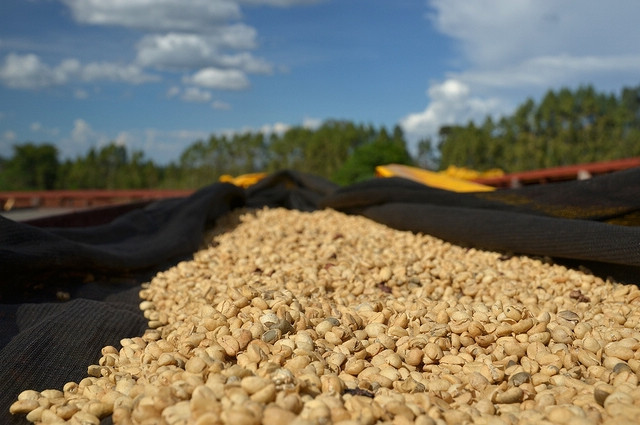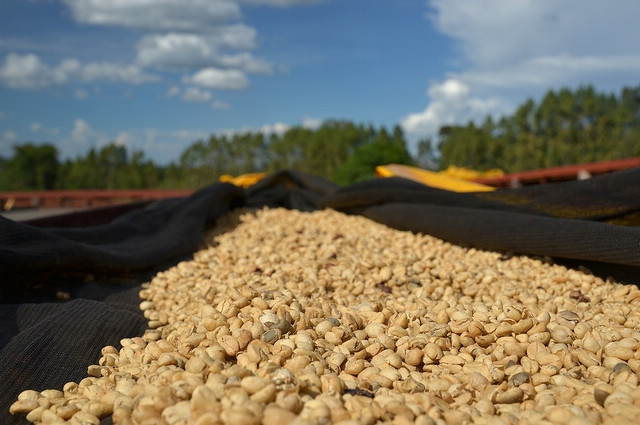Royal Coffee processing Plant in St. Roman, a country grown in Central America, Tarazu, Costa Rica.
Costa Rican coffee cultivation was introduced from Cuba in 1779 and exported for the first time in 1820. There are about 32,000 coffee farmers in Costa Rica, with an average cultivation area of less than one hectare (10,000 m2) per farmer. Costa Rica has a population of 4.1 million (2006), 82,500 hectares of coffee cultivation area, an annual production of 1.7 million bags (60kgs per bag), and an annual domestic consumption of 380,000 bags, with an average annual consumption of 5.5 kgs per person, which is higher than Japan's (consumption of 4 kgs).
Costa Rica was the first country to introduce coffee into Central America. It has a long history and a complete coffee organization system from production to sales. Because it is located in the Central American Isthmus, there are many volcanoes in the territory, it has the natural advantages of sunshine and land, and the climate is simultaneously reconciled by the Pacific Ocean and Atlantic Ocean currents and sea breezes. The coffee produced has the characteristics of local micro-climate and terroir conditions. In terms of quality and quantity, Costa Rica's coffee has always been recognized by the world and has been rated as one of the world's high-quality coffees. Costa Rica coffee has been cultivated for 200 years, first planted in Poas and Barva volcanic slopes, today known as the Central Valley (Central Valley), the main seven coffee growing areas are from northwest to southeast, along the inland Central Plateau distribution.
Fertile volcanic ash, mild temperatures, and steady rainfall are among the factors that have made coffee a major agricultural product in Colombia. The seven regions are Tarrzu, Tres Rios, Orosi, Central Valley, West Valley, Turrialba and Brunca.
Flavor Description: Berry fruity, caramel, creamy, slightly spicy.

Important Notice :
前街咖啡 FrontStreet Coffee has moved to new addredd:
FrontStreet Coffee Address: 315,Donghua East Road,GuangZhou
Tel:020 38364473
- Prev

Introduction to the Origin of Fine Coffee beans from Nicaragua the characteristics of Nicaraguan Coffee
In many countries, coffee production has been seriously affected for political reasons. Nicaraguan coffee industry is no exception. The 1979 revolution forced coffee planters to flee to Miami. A period of indecision followed, when the government considered whether to redistribute land, including many plantations, which led to a shortage of coffee and a decline in production. Niagara
- Next

American coffee beans Panamanian Ireta Manor SHB Kaddura specially selected imported high-quality boutique coffee
Panama MC Santa Clara Eleta SHB Washed country: Panama Grade: SHB producing area: Santa Clara altitude: average 1600 m treatment: washed varieties: Kaddura Manor: Iletta Manor Flavor: bread and cream, apricot sweet, sour round coffee was introduced to Panama in 1780, it began when Europeans introduced the first Typica tree species.
Related
- Detailed explanation of Jadeite planting Land in Panamanian Jadeite Manor introduction to the grading system of Jadeite competitive bidding, Red bid, Green bid and Rose Summer
- Story of Coffee planting in Brenka region of Costa Rica Stonehenge Manor anaerobic heavy honey treatment of flavor mouth
- What's on the barrel of Blue Mountain Coffee beans?
- Can American coffee also pull flowers? How to use hot American style to pull out a good-looking pattern?
- Can you make a cold extract with coffee beans? What is the right proportion for cold-extracted coffee formula?
- Indonesian PWN Gold Mandrine Coffee Origin Features Flavor How to Chong? Mandolin coffee is American.
- A brief introduction to the flavor characteristics of Brazilian yellow bourbon coffee beans
- What is the effect of different water quality on the flavor of cold-extracted coffee? What kind of water is best for brewing coffee?
- Why do you think of Rose Summer whenever you mention Panamanian coffee?
- Introduction to the characteristics of authentic blue mountain coffee bean producing areas? What is the CIB Coffee Authority in Jamaica?

